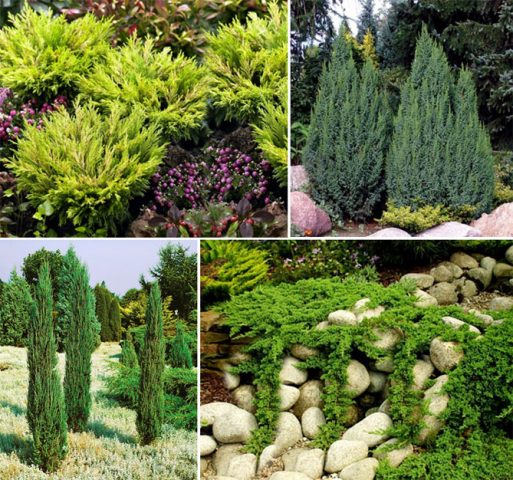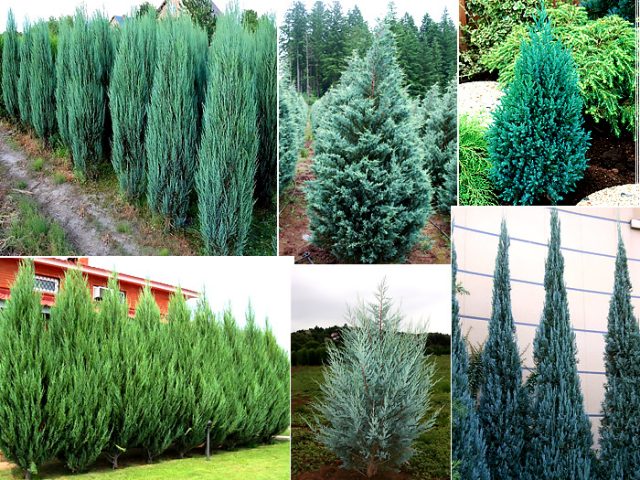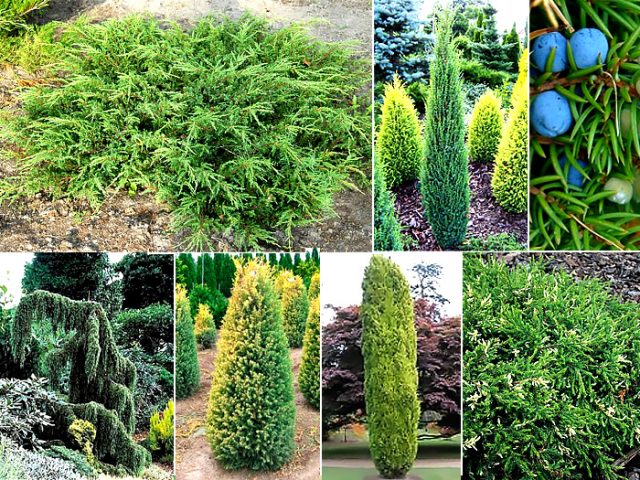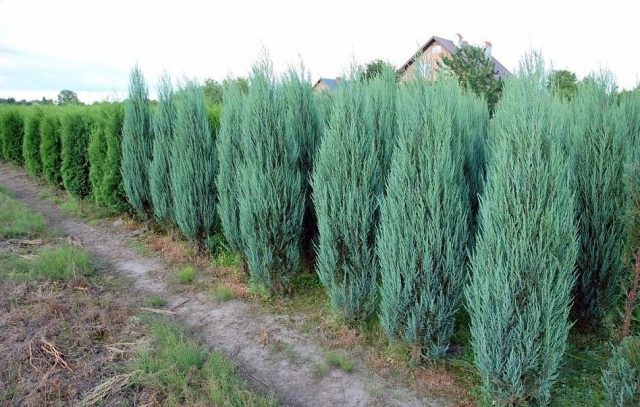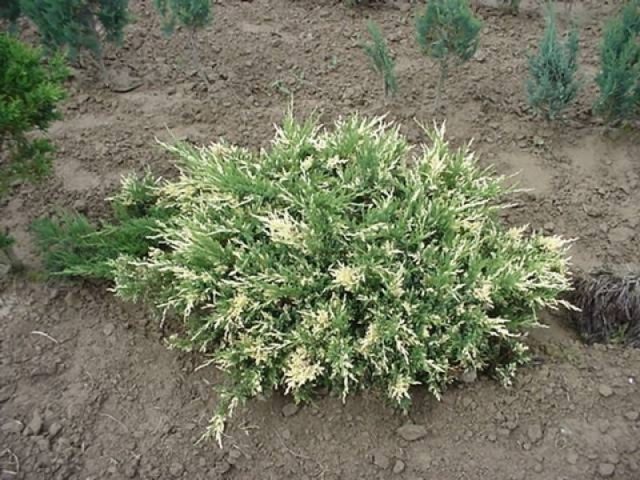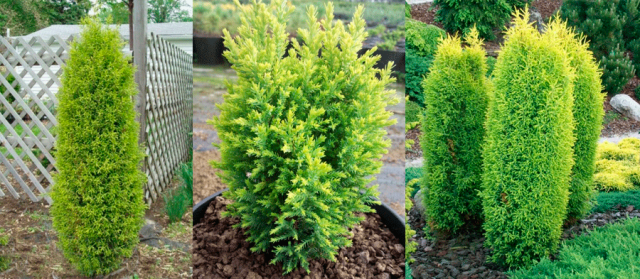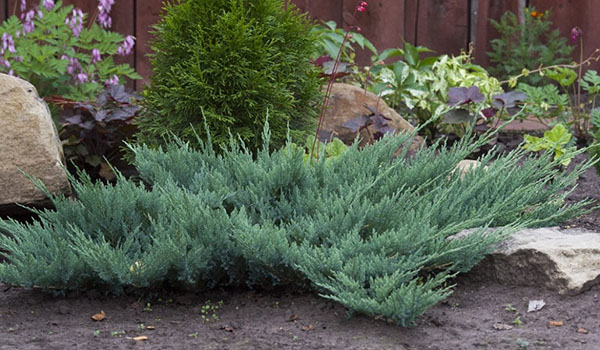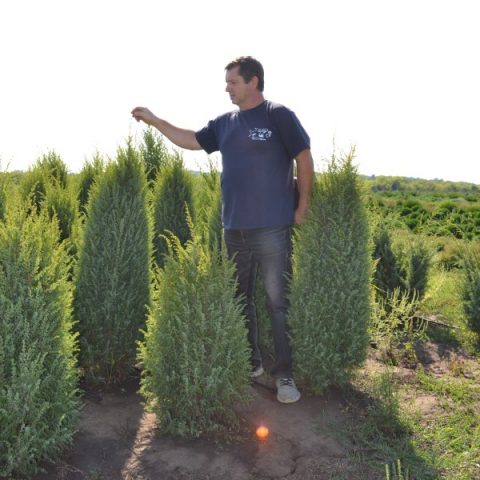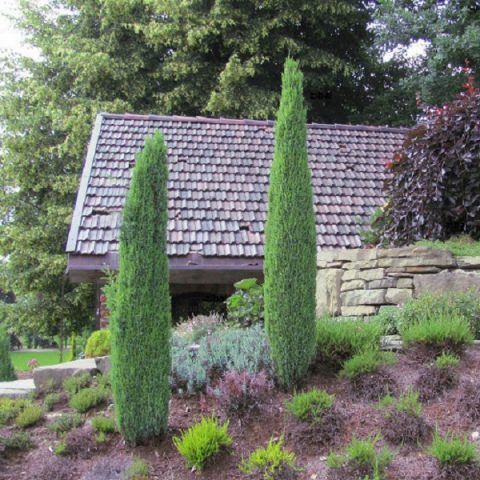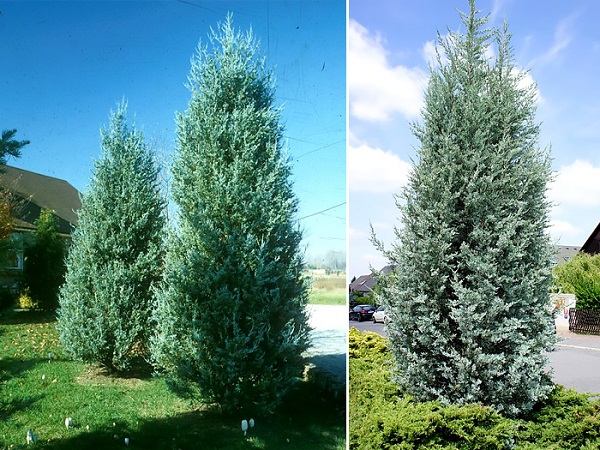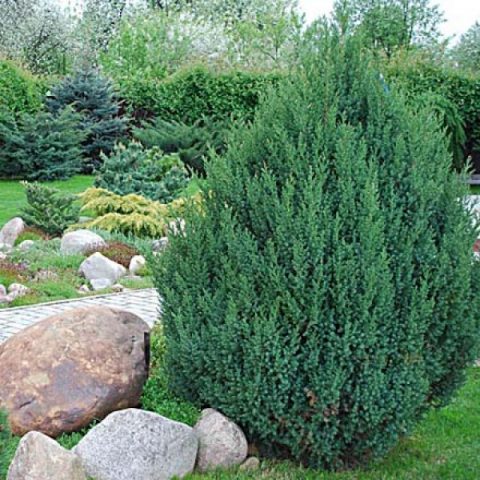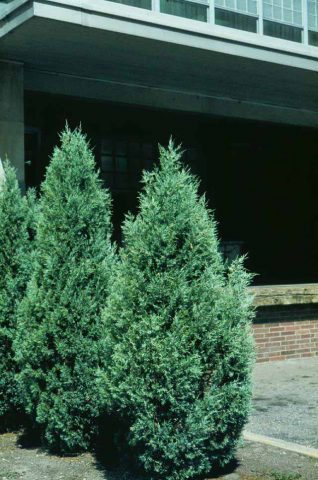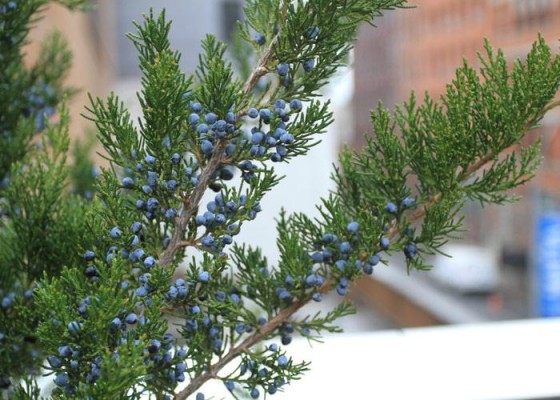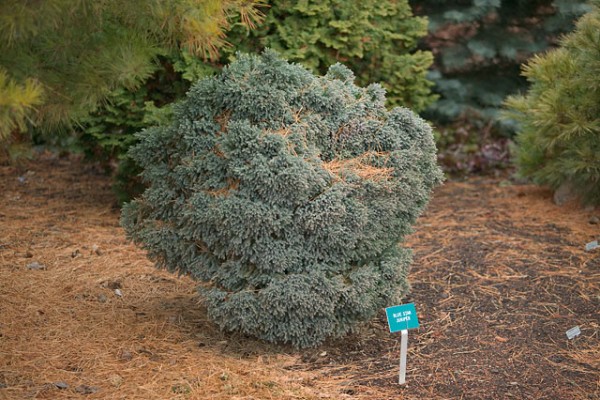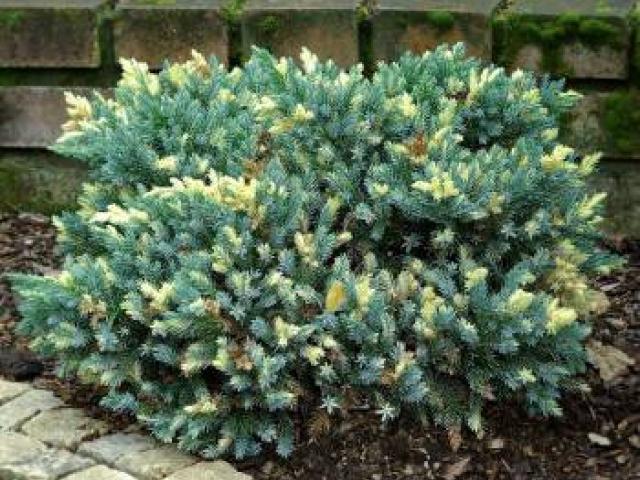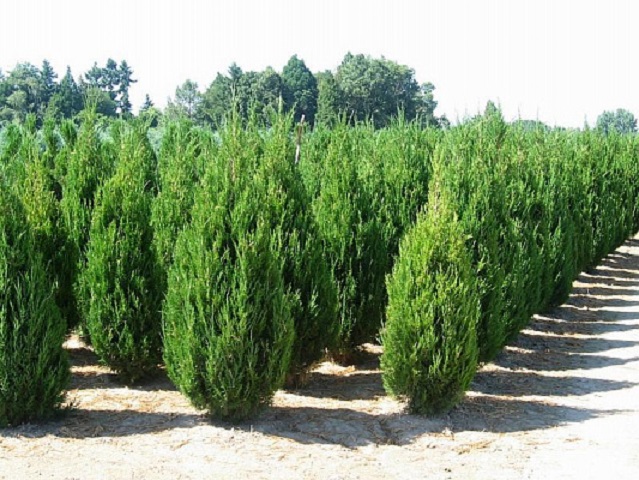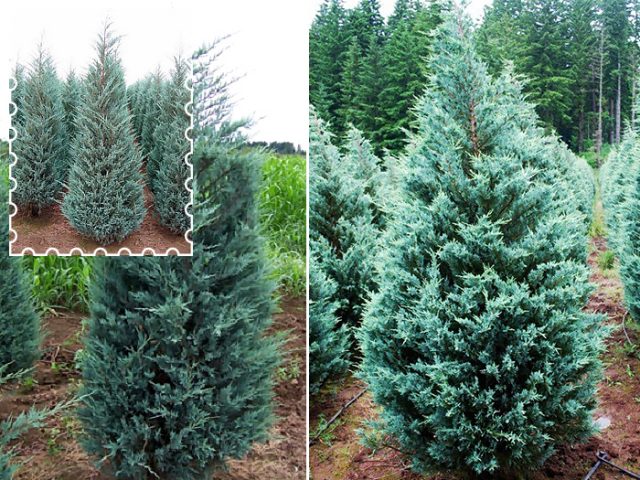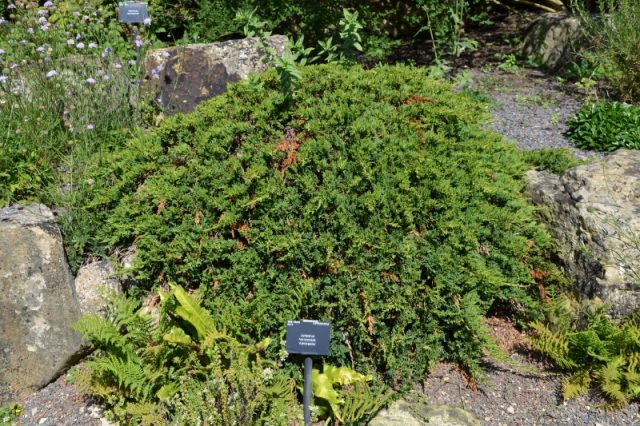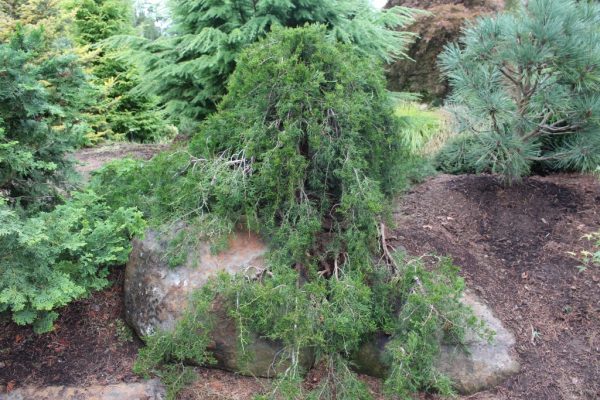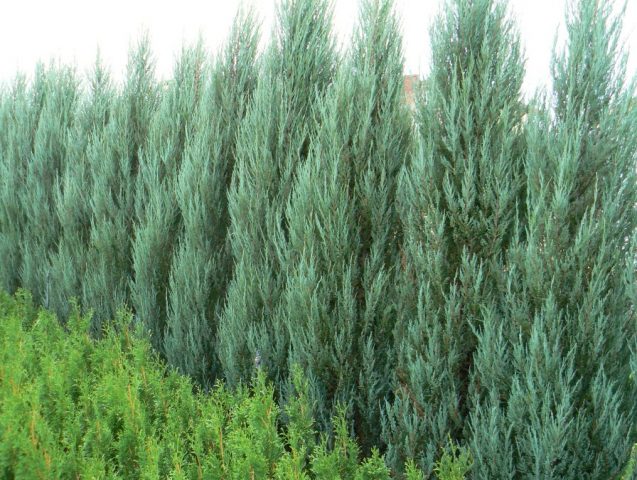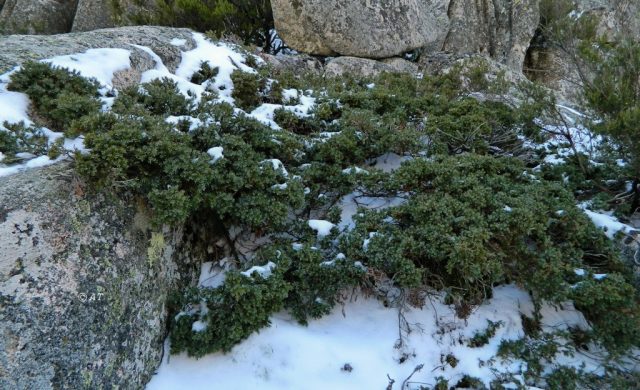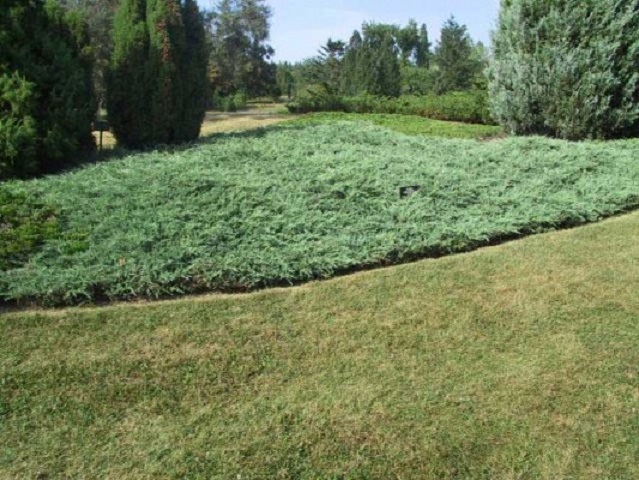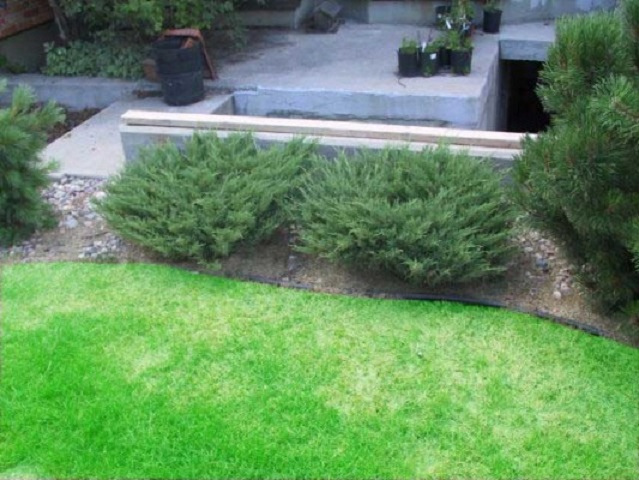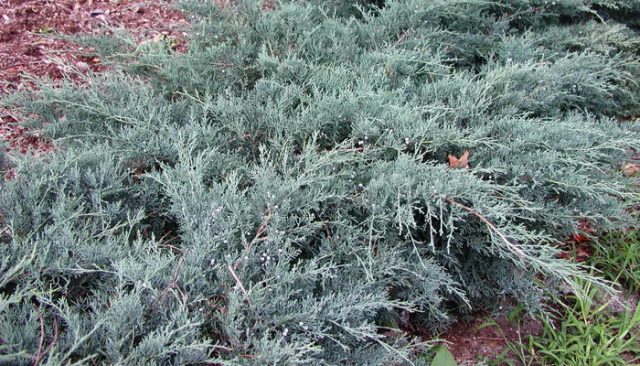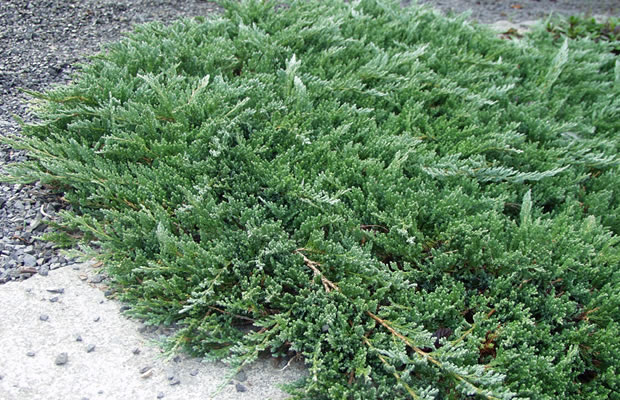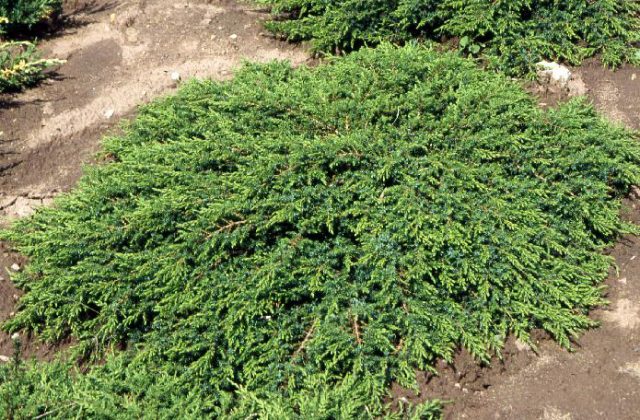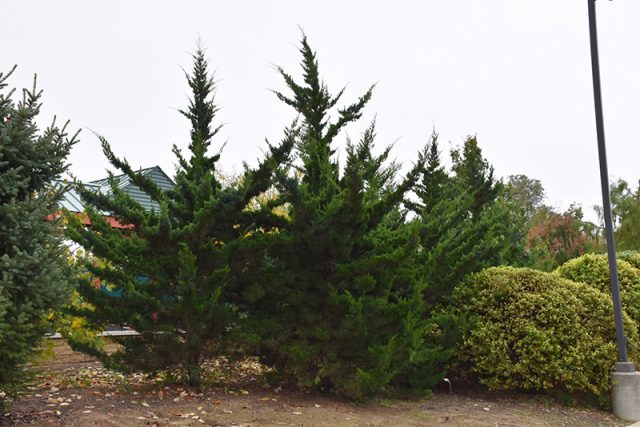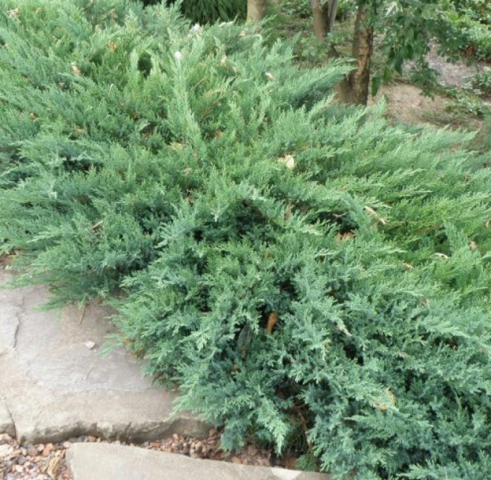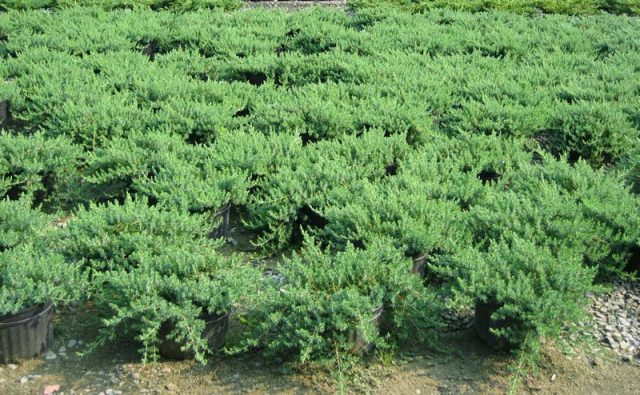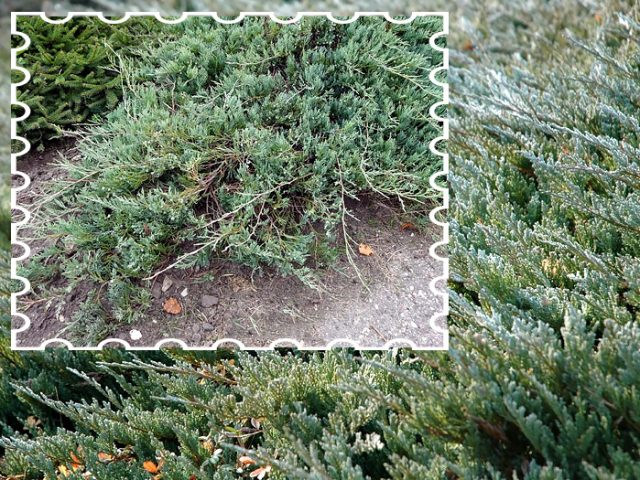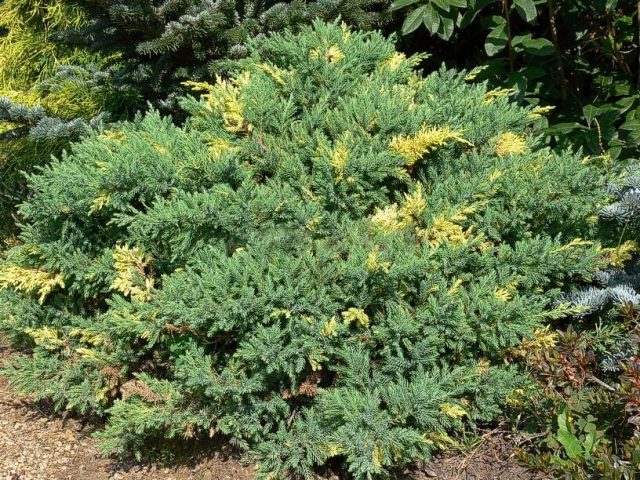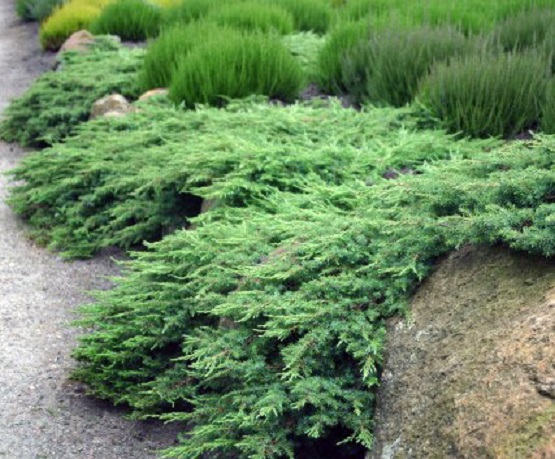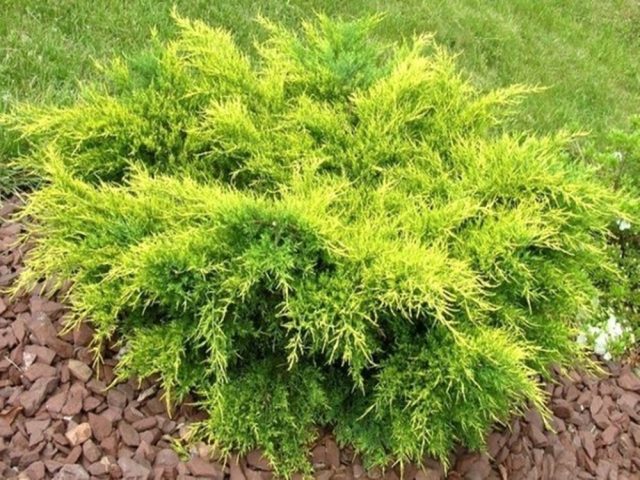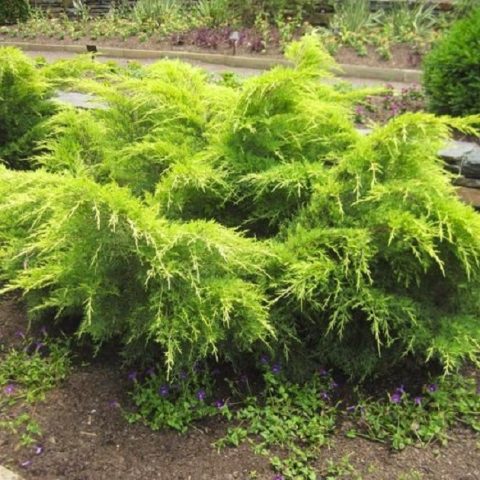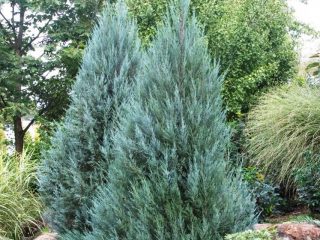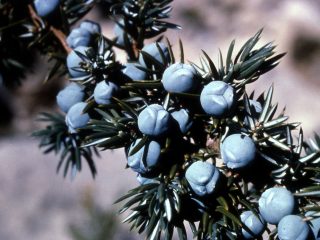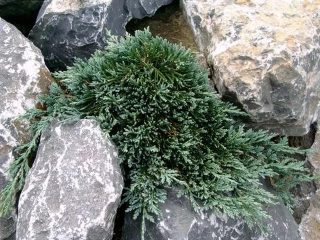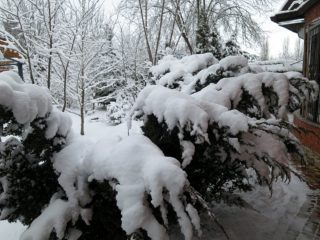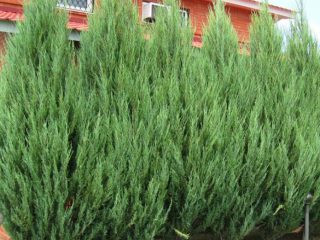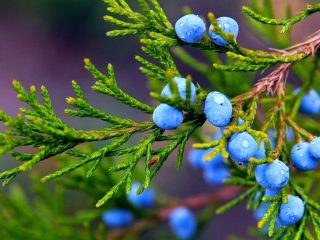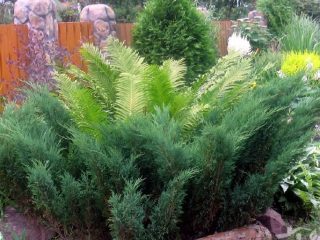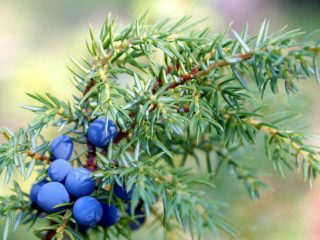Content
- 1 What types of juniper are there?
- 2 The best varieties of juniper
- 3 Vertical varieties of juniper
- 4 Globular varieties of juniper
- 5 Fast-growing juniper varieties
- 6 Frost-resistant juniper varieties
- 7 Shade-tolerant juniper varieties
- 8 Ground cover varieties of juniper
- 9 Juniper varieties with a spreading crown
- 10 Conclusion
Types and varieties of juniper with photos and brief descriptions will help owners of their plots in choosing plants for the garden. This crop is hardy, decorative, and does not have the same requirements for growing conditions as other conifers. It is incredibly diverse. The garden can be filled with just different types of junipers, and still, with skillful selection of varieties, it will not look monotonous.
What types of juniper are there?
Juniper (Juniperus) is a genus of evergreen coniferous plants belonging to the Cypress family (Cupressaceae). It includes more than 60 species distributed throughout the Northern Hemisphere. It is impossible to give an exact figure, since the classification of junipers is still controversial.
The range extends from the Arctic to tropical Africa. Junipers grow as undergrowth in coniferous and light deciduous forests, forming thickets on dry rocky hills, sands, and mountain slopes.
The culture is undemanding to soil; the powerful root can extract the nutrients and moisture necessary for the plant from great depths or poor soil. All types of junipers are unpretentious, drought-resistant, grow well in full sun, but tolerate partial shade. Most are highly frost-resistant and can withstand -40° C without shelter.
The age of species of junipers can be hundreds and thousands of years. Varieties live much less.In addition, the duration of their existence is greatly influenced by their low resistance to anthropogenic pollution.
In different types of juniper, the plant can be:
- a tall tree measuring 20-40 m, like Juniperus virginiana;
- a shrub with long branches spread over the ground, for example, Horizontal and Recumbent junipers;
- a medium-sized tree with several trunks, reaching 6-8 m by the age of 30 (Common and Rocky juniper);
- shrub with ascending straight or drooping branches up to 5 m long, among which are the Kazatsky and Middle junipers.
The juvenile needles of the culture are always prickly, 5-25 mm long. With age, it may remain completely or partially sharp, or change to scaly, which is much shorter - from 2 to 4 mm. In such decorative juniper species as Chinese and Virginia, one mature specimen grows both types of needles - soft scaly and prickly needle-shaped. The latter is most often located at the top or ends of old shoots. Shading also helps preserve the juvenile shape of leaves.
The color of the needles differs not only among different types of junipers, it varies from variety to variety. The culture is characterized by a color ranging from green to dark green, gray, and silver. Often, which is especially clearly visible in the photo of decorative junipers, the needles have a pronounced blue, light blue or golden tint.
Trees can be monoecious, in which male and female flowers are located on the same specimen, or dioecious. In these types of junipers, the anthers and cones are located on different plants. It is noteworthy that female specimens usually form a wide, spreading crown, while male specimens form a narrow one, with closely spaced branches.
The cone berries are round in shape, depending on the type, can have a diameter of 4-24 mm, from 1 to 12 seeds. To mature, they need from 6 to 16 months after pollination. Most often, the fruits are dark blue, sometimes almost black, covered with a bluish coating.
There are many varieties of junipers, photos and names of which can be found on the Internet or reference books. It is impossible to mention everything in one article. But it is quite possible to give a general idea of the crop for beginning gardeners, and to remind experienced gardeners of the diversity of junipers and help them find a suitable variety for the garden.
Don't forget about juniper hybrids. Most often, Virginian and Rocky are crossed in nature at the border of the population. The most successful, perhaps, is Juniperus x pfitzeriana or Middle Juniper (Fitzer), obtained by crossing Kazatsky and Chinese, and which gave many excellent varieties.
The best varieties of juniper
Of course, this is a matter of taste. But the juniper varieties proposed for consideration with photos and descriptions are often used in the design of public and private gardens and are popular all over the world.
Rock juniper Blue Arrow
One of the most popular varieties, Juniperus scopolorum Blue Arrow, was bred by American breeders in 1949. It is characterized by a narrow cone-shaped crown and densely growing shoots raised upward.
By the age of 10 years, juniper reaches a height of 2 m and a width of 60 cm. It holds its shape well without pruning.
Juvenile needles are needle-shaped, on mature trees they are scaly, green with a distinct blue tint.
Widely used in landscaping as a vertical accent. Blue Arrow is planted as part of landscape groups; trees of this variety can be used to create an alley or hedge.
Without shelter, it overwinters in frost resistance zone 4.
Cossack juniper Variegata
The tips of the shoots of Juniperus sabina Variegata are white or cream-colored, which fades when planted in partial shade. Juniper grows slowly, at 10 years it reaches 40 cm and about 1 m in width. The height of an adult bush is 1 m, crown diameter is 1.5 m.
The branches are spreading, almost horizontal, but rarely come into contact with the ground, only at the base of the plant. The ends of the shoots are raised.
The variety tolerates low temperatures well, but the white tips may freeze slightly. Young growth especially does not like return frosts. In order not to spoil the appearance, frozen needles are cut off.
Common juniper Gold Con
In Germany, in 1980, the variety Juniperus communis Gold Cone was created, which has a rare golden-green color of needles. The branches are directed upward, but are located quite freely, especially at a young age. The crown has the shape of a cone, rounded at the top. With even care, that is, if years of increased care are not replaced by a complete lack of attention, it holds its shape well without trimming.
The variety has average growth vigor, adding 10-15 cm per season. The height of a 10-year-old tree is 2-3 m, crown diameter is about 50 cm.
Prefers to be planted in the sun. In partial shade, the Gold Con variety loses its golden color and becomes simply green.
Horizontal juniper Blue Chip
The name of the variety is translated as Blue Chip.Juniper has earned popularity thanks to its beautiful neatly shaped crown spread across the ground and bright blue needles.
This ornamental shrub grows slowly for juniper, adding 10 cm annually. It can reach 30 cm in height and spreads 1.2 m in width. The crown looks quite compact and maintains an attractive shape without trimming.
The shoots spread along the surface of the soil, the ends rise slightly. The thick, scaly needles change from blue to purple in winter.
Winters in zone 5.
Chinese juniper Obelisk
The famous variety Juniperus chinensis Obelisk was bred in the Boskop nursery (Netherlands) in the early 30s of the 20th century by sowing seeds obtained from Japan.
It is a branched tree, which at a young age has a conical crown with a sharp apex. Every year the height of the Obelisk variety increases by 20 cm, reaching 2 m by the age of 10 years with a width at the base of up to 1 m.
Later, the growth rate of juniper slows down. At 30 years old, the height is about 3 m with a crown diameter of 1.2-1.5 m. The tree becomes like a wide, slender column with an irregular crown.
Shoots grow at an acute upward angle. Mature needles are hard, sharp, bluish-green in color, young ones are bright green.
Without shelter it winters in zone 5.
Vertical varieties of juniper
Varieties of many types of junipers have an upward-pointing crown. It is noteworthy that almost all of them belong to monoecious plants, or male specimens. Tall varieties of juniper with a narrow straight or wide pyramidal crown are always popular.Even in a small garden they are planted as a vertical accent.
Common juniper Sentinel
The name of the variety Juniperus communis Sentinel translates as sentry. Indeed, the plant is distinguished by a very narrow vertical crown, rarely found in junipers. The variety appeared in the Canadian nursery Sheridan in 1963.
An adult tree grows 3-4 meters in height, while its diameter does not exceed 30-50 cm. The branches are vertical, dense, located close to the trunk. The needles are prickly, the growth is bright green, old needles become dark and acquire a bluish tint.
The variety has very high frost resistance - zone 2 without shelter. Wood can be used to create topiary shapes.
Rock juniper Blue Haven
The name of the American variety Juniperus scopulorum Blue Heaven, created in 1963, is translated as Blue Sky. Indeed, the color of juniper needles is unusually bright, rich, and does not change throughout the season.
The annual growth is about 20 cm, by the age of 10 the height is 2-2.5 m, and the diameter is 0.8 m. Old specimens reach 4 or 5 m, width - 1.5 m. A special feature is annual fruiting, which weakens tree. It needs to be fed more intensively than other varieties. Frost resistance is the fourth zone.
Chinese juniper Stricta
One of the most popular juniper varieties in the post-Soviet space is Juniperus chinensis Stricta, bred in 1945 by Dutch breeders.
Numerous ascending, evenly spaced branches form a symmetrical, narrow-pointed crown with a sharp tip. The variety has an average growth force and annually adds 20 cm. By the age of 10, it reaches a height of up to 2.5 m and a width of 1.5 m at the base of the crown.
The needles are only needle-shaped, but quite soft, bluish-green on top, the lower part is whitish, as if covered with frost. In winter it changes color to gray-yellow.
Trees belonging to this variety in urban environments live for about 100 years.
Virginia juniper Glauka
The old variety Juniperus virginiana Glauca, which has remained popular in France since 1868, was first described by E. A. Carriere. For more than a century and a half, it has been grown by many nurseries and has undergone some changes.
Now, under the same name, different manufacturers sell trees with a narrow pyramidal or columnar lush crown, beyond which individual branches often protrude. This makes the juniper appear wider than it is.
The variety grows quickly, an adult tree reaches 5-10 m with a diameter of 2-2.5 m. A distinctive feature is the young silver-blue needles, which become blue-green over time. On adult plants, the needles are scaly, remaining sharp only in the shade or inside the dense crown. In the northern regions, in winter the needles turn brown.
Virginia juniper Korkorkor
In Russia, the variety Juniperus virginiana Corcorcor is rare, as it is relatively new and is protected by a patent. Created in 1981 by Clifford D. Corliss (Brothers Nursery Inc., Ipswich, MA).
The variety is similar to the original species, but has a dense crown, similar to a wide column, dense branches and more slender forms.According to the patent, the cultivar has twice as many side branches and are much thicker.
Young needles are emerald green, fade a little with age, but remain shiny and do not acquire a gray tint. The needles last much longer than the species without exposing the branches.
After 10 years, Korkorkor reaches a height of 6 m and a diameter of 2.5 m. The trees can be grown into a hedge or alley, but planting as a tapeworm is not recommended.
The Korkorkor variety is a female fruiting plant propagated only by cuttings. Seeds can be germinated, but seedlings do not inherit maternal characteristics.
Globular varieties of juniper
This form is uncharacteristic for junipers. Small young plants can have it, but when they grow up, most often the outline of the crown changes. And then it is difficult to maintain them even with regular haircuts.
But the round shape is very attractive for the garden. Types of juniper with names and photos that can support a more or less spherical crown are described below.
Chinese juniper Echiniformis
The dwarf variety Juniperus chinensis Echiniformis was created in the late 80s of the 19th century by the German nursery SJ Rinz, located in Frankfurt. Common in Europe, but sometimes incorrectly classified as species communis.
It forms a round or flattened spherical crown, from which branches grow in different directions. A clear configuration can be achieved by regular pruning.
The shoots are dense and short, the needles inside the crown are needle-shaped, at the ends of the shoots they are scaly and bluish-green. It grows very slowly, adding about 4 cm per season, and by 10 years it reaches a diameter of 40 cm.
The variety is clearly derived from the witch's broom and propagates only vegetatively. Frost resistance – zone 4.
Scaly juniper Blue Star
Juniperus squamata Blue Star originated from a witch's broom found on the Meyeri cultivar in 1950. It was introduced into cultivation by the Dutch nursery Rooywijk in 1964. The name of the variety translates as Blue Star.
Blue Star grows very slowly - 5-7.5 cm per year, by the age of 10 it reaches approximately 50 cm in height with a width of 70 cm. The dimensions are named very arbitrarily, since the shape of the crown is difficult to determine accurately. Sometimes it is called “flaky,” and this is perhaps the most accurate definition.
The Blue Star variety branches in layers, and where they go depends on many factors, including pruning. The crown can be spherical, cushion-shaped, stepped, and cannot be defined in any way. But the bush always looks attractive and original, which only adds to the popularity of the variety.
The needles are sharp, hard, bluish-steel in color. Frost resistance zone – 4.
Scaly juniper Floreant
Juniperus squamata Floreant is a mutation of the famous Blue Star variety, and received its name in honor of the Dutch football club. Frankly speaking, it doesn’t look much like a ball, but it’s hard to expect more rounded shapes from juniper.
Floreant is a dwarf bush with dense short shoots that form an irregularly shaped ball at a young age. When the plant reaches maturity, the crown spreads out and becomes like a hemisphere.
The juniper Floreant differs from the mother variety Blue Star in its variegated needles. The young growth is creamy white and looks great against a silvery blue background. If we take into account that the shoots stick out unevenly, and the light spots are scattered chaotically, then each bush becomes unique.
At the age of 10 it reaches a height of 40 cm with a diameter of 50 cm. Frost resistance - zone 5.
Common Berkshire juniper
It is difficult to call Juniperus communis Berkshire a ball. The variety is more like a hummock; it can even be a stretch to describe it as a hemisphere.
Numerous reddish branches grow close to each other, forming a semicircular hill up to 30 cm high and about 0.5 m in diameter. While the growth of the shrub is easy to measure, the width of the crown is problematic - it does not adhere to clear boundaries and spreads out. To keep it “within limits”, if you need clear contours, you can only trim it.
The Berkshire variety has an interesting coloring of needles: young growths are light green, and old needles are blue with a silver stripe. This is clearly visible in the photo. In winter it takes on a plum tint.
Fast-growing juniper varieties
Perhaps the fastest growing is rock juniper and most of its varieties. And many horizontal species intensively spread in width.
Chinese juniper Spartan
The variety Juniperus chinensis Spartan was obtained in 1961 by the Monrovia nursery (California). It is a tall tree with dense, upturned branches forming a pyramidal crown.
This is one of the fastest growing varieties; it grows more than 30 cm per year. After 10 years, the plant can stretch up to 5 m, the width will be from 1 to 1.6 m. Old specimens reach 12-15 m with a diameter in the lower part of the crown of 4.5-6 m. The needles are dark green and thick.
The variety is highly resistant to urban conditions and winters in zone 3. It tolerates pruning well and is suitable for creating topiary.
Rock juniper Moonglow
The popular variety Juniperus scopulorum Moonglow in the famous Hillside nursery was created in the 70s of the 20th century. Translation of the name of juniper is Moonlight.
It grows very quickly, annually increasing by more than 30 cm. By the age of 10, the size of the tree reaches at least 3 meters with a crown diameter of 1 m. At 30, the height will be 6 m or more, the width will be about 2.5 m. After this, the size of the juniper continues to increase, but slowly.
Forms a dense pyramidal crown with strong branches raised upward. A mature tree may require light pruning to maintain it. The needles are silver-blue. Wintering without shelter - zone 4.
Horizontal juniper Admirabilis
The variety Juniperus horizontalis Admirabilis is a vegetatively propagated male clone. This is a ground cover juniper with great growth vigor, suitable not only for garden decoration. It can slow down or prevent soil erosion.
It is a fast-growing shrub about 20-30 cm high, with shoots spread along the ground, covering an area of 2.5 m or more. The needles are needle-shaped, but soft, bluish-green; in winter they change color to dark green.
Virginia juniper Reptans
An original old variety, the species of which scientists have not reached a consensus on. Some believe that this is not just a Virginia juniper, but a hybrid with a horizontal one.
Juniperus virginiana Reptans was first mentioned in 1896 by Ludwig Beisner. But he was describing an old specimen, which did not have long to live, growing in Jena's garden. So the exact date of creation of the variety is unknown.
The appearance of Reptans can be called awkward, but this does not make it any less desirable for amateur gardeners around the world. The variety is a weeping tree with branches growing horizontally and drooping side shoots.
Reptans grows quite quickly, adding more than 30 cm per year.By the age of 10, it will reach a height of 1 m, and scatter branches over an area whose diameter can exceed 3 m. With the help of pruning, it is easy to control the crown of the tree, giving it the desired shape.
The needles are green, becoming bronze in winter. In spring, the tree is decorated with tiny golden cones. There are no berries as it is a clone of a male plant.
Rock juniper Skyrocket
One of the most famous varieties of Juniperus scopulorum Skyrocket was created by the American nursery Shuel (Indiana).
It grows quickly, reaching 3 m or more by the age of 10 years. At the same time, the diameter of the crown does not exceed 60 cm. The branches raised up and pressed against each other form an exceptionally beautiful crown in the form of a narrow cone with the top directed to the sky.
The needles are blue, young ones are prickly, and in adult plants they are scaly. In the middle of the crown, at the top and ends of old branches, it may remain needle-like.
It tolerates pruning well and overwinters in zone 4. The main disadvantage is that it is highly susceptible to rust.
Frost-resistant juniper varieties
The culture is distributed from the Arctic to Africa, but even many southern species, after adaptation, can withstand low temperatures well. The most frost-resistant juniper is Siberian. Below are descriptions of varieties that grow without shelter in zone 2.
Common juniper Meyer
German breeder Erich Meyer created juniper in 1945, which became one of the most popular - Juniper communis Meyer. The variety is decorative, undemanding in care, frost-resistant and stable.You can safely propagate it by cuttings yourself, without fear that it will “sport.”
This kind of trouble happens all the time. Conscientious growers in nurseries constantly reject not only seedlings, but also plants grown from cuttings if they do not correspond to the variety. This is difficult for amateurs to do, especially since small junipers bear little resemblance to adults.
Meyer is a multi-stemmed bush with a symmetrical pin-shaped crown. The skeletal branches are thick, with a large number of lateral shoots, the ends of which sometimes droop. They are located evenly in relation to the center. An adult juniper reaches a height of 3-4 m and a width of about 1.5 m.
The needles are prickly, silver-green, young ones are somewhat lighter than mature ones, and in winter they acquire a bluish tint.
Juniper Siberian
Some scientists identify the crop as a separate species, Juniperus Sibirica, while others consider it a variation of the common juniper - Juniperus communis var. Saxatilis. In any case, this shrub is widespread and grows under natural conditions from the Arctic to the Caucasus, Tibet, Crimea, Central and Asia Minor. In culture - since 1879.
This is a juniper with a creeping crown, usually not exceeding 0.5 m at 10 years. The diameter is difficult to determine, since thick shoots with short internodes tend to take root and form thickets in which it is difficult to determine where one bush ends and another begins.
The dense needles are silver-green and do not change color depending on the season. Cone berries ripen in June-August of the year following pollination.
Cossack juniper Arcadia
The Juniperus sabina Arcadia variety was created in D. Hill's nursery from Ural seeds in 1933, and was put up for sale only in 1949. Today it is considered one of the most hardy and frost-resistant.
It is a creeping, slow-growing shrub. By the age of 10 it has a height of 30 to 40 cm, after 30 it is about 0.5 m. The width is 1.8 and 2 m, respectively.
The shoots are located in a horizontal plane and evenly cover the soil. The branches do not stick up; there is no need to “pacify” them by pruning.
Juvenile needles are needle-shaped, on an adult bush they are scaly and green. Sometimes the color has a bluish or blue tint.
Horizontal juniper Dunvegan Blue
Today, the hardiest and most frost-resistant of the junipers with an open crown and blue needles is Juniperus horizontalis Dunvegan Blue. The specimen that gave rise to the variety was found in 1959 near Dunvegan (Canada).
This juniper with shoots spreading along the ground looks like a ground cover thorny plant. An adult bush reaches a height of 50-60 cm, while spreading branches up to 3 m wide.
The needles are prickly, silver-blue, turning purple in the fall.
Horizontal juniper Youngstown
Among the junipers bred by the Plumfield nursery (Nebraska, USA), Juniperus horizontalis Youngstown takes pride of place. It appeared in 1973, gained popularity in America and Europe, but is rarely found in Russia.
This original variety is often confused with Andora Compacta, but there are significant differences between the cultivars. At the first frost, the crown of Youngstown acquires a purple-plum color unique to this juniper. As temperatures drop, it becomes increasingly saturated, returning to dark green in the spring.
Youngstown juniper forms a low, flat bush 30-50 cm high and 1.5 to 2.5 m wide.
Shade-tolerant juniper varieties
Most junipers are light-loving, only some are shade-tolerant. But with a lack of sun, the appearance of the plant suffers more than its health.
Virginia and horizontal junipers tolerate shade best, but each species has varieties that can grow in the absence of sun.
Cossack juniper Blue Danub
At first, the Austrian Juniperus sabina Blue Danube went on sale without a name. It was named Blue Danube in 1961, when the variety began to gain popularity.
Blue Danube is a creeping shrub with upturned branch tips. An adult plant reaches 1 m in height and 5 m in diameter with a dense crown. Every year the shoots increase by about 20 cm.
Young junipers have prickly needles. A mature bush retains it only inside the crown; at the periphery, the needles become scaly. The color when grown in the sun is bluish, in partial shade it becomes grayish.
Horizontal juniper Glauka
The American variety Juniperus horizontalis Glauca is a creeping shrub. It grows very slowly, at a young age it is a real dwarf, which by the age of 10 rises above the ground by 20 cm and covers an area with a diameter of 40 cm. At 30 its height is about 35 cm, the crown width is 2.5 m.
The ropes diverge evenly from the center of the bush, are densely covered with lateral shoots, tightly pressed to the ground or layered on top of each other. The needles are steel-blue and retain the same color throughout the season.
Common juniper Green Carpet
In Russian, the name of the famous variety Juniperus communis Green Carpet sounds like Green Carpet. It grows almost horizontally, evenly covering the soil. At 10 years old, its height reaches 10 cm, width - 1.5 m. An adult juniper scatters branches up to 2 m, and rises above the ground by 20-30 cm.
The shoots are pressed to the ground or layered on top of each other. The needles are needle-shaped, but rather soft and green. Young growth is a shade lighter in color than mature needles.
Virginia juniper Canaherty
The juniper Juniperus virginiana Сanaertii is considered to be quite shade-tolerant. This is true for young plants. It was not tested on an adult - it’s just difficult to hide a 5-meter tree in the shade on a private plot. And in city parks, junipers are not planted very often - low resistance to air pollution is a hindrance.
Kaentry forms a slender tree with a crown in the form of a column or a narrow cone. The branches are dense, with short branches, raised upward. The ends of the shoots hang down picturesquely. The variety has average growth vigor, its shoots lengthen by 20 cm per season.
The maximum size of the tree is 6-8 m with a crown diameter of 2-3 m. The needles are bright green, somewhat dull in partial shade.
Cossack juniper Tamariscifolia
The famous old variety Juniperus sabina Tamariscifolia has long been inferior to new junipers in decorativeness and stability. But it is invariably popular, and it is difficult to name a cultivar that is planted more often in Europe.
The variety grows slowly, by the age of 10 it rises 30 cm above the ground and scatters branches 1.5-2 m in diameter. The shoots first spread in a horizontal area, then bend upward.
The thick gray-green needles become ashen in the shade. This is perhaps the only variety that can survive in the shade. Of course, there the plant will look sick, and its color can be called gray with a slight green tint. But, if it is regularly sprayed with zircon and epin, with 2-3 hours of light a day, it can exist for years.
Ground cover varieties of juniper
Attractive varieties of juniper, reminiscent of a prickly carpet, or rising to a small height above the ground surface, are very popular. Just don’t confuse them with a lawn—you can’t walk on prostrate plants.
Coastal Juniper Blue Pacific
The slow-growing, frost-resistant variety Juniperus conferta Blue Pacific is sometimes called dwarf, but this is incorrect. It is small only in height - about 30 cm above ground level. Blue Pacific grows 2 m or more in width.
Numerous shoots forming a thick carpet spread along the ground. However, you cannot walk on them - the branches will break and the bush will lose its decorative effect. Juniper is covered with bluish-green long needles, prickly and tough.
In the second year after pollination, small blueberry-like blueberries, covered with a waxy coating, ripen. If it is rubbed off, the fruit will show a dark blue, almost black color.
Horizontal juniper Bar Harbor
Frost-resistant varieties that tolerate planting in partial shade include Juniperus horizontalis Bar Harbor. It is a creeping shrub with thin branches spread along the ground. Young shoots rise slightly, the plant reaches a height of 20-25 cm by the age of 10. At the same time, the juniper covers an area with a diameter of up to 1.5 m.
The bark on young branches is orange-brown, the needles are prickly, pressed against the shoots. In the light it is dark green, in partial shade it is grayish. When the temperature drops below 0°C it takes on a reddish tint.
Horizontal Juniperus Douglasii
Among the creeping varieties resistant to air pollution, Juniperus horizontalis Douglasii should be mentioned. It withstands low temperatures well and is shade-tolerant.
Forms a bush spread on the ground with shoots completely covered with needles. The Douglasie variety reaches a height of 30 cm with a width of about 2 m. Blue needle-shaped needles take on a purple hue in winter.
Looks good in single and group plantings and can be used as a ground cover plant. When planting, it should be taken into account that over time, Douglas juniper will spread over a large area.
Chinese juniper Expansa Aureospicata
On sale, and sometimes in reference books, Juniperus chinensis Expansa Aureospicata can be found under the name Expansa Variegata. When buying a seedling, you need to know that it is the same variety.
A creeping shrub, at 10 years of age reaching a height of 30-40 cm and spreading 1.5 m. An adult plant can grow up to 50 cm or more, covering an area of 2 m.
The variety is distinguished by its variegated color - the tips of the shoots are yellow or cream, the main color of the needles is bluish-green. The light color is fully visible only in the most illuminated place.
Juniper Expansa Aureospicata is quite frost-resistant, but the tips of the yellow shoots may freeze. They just need to be cut with scissors or pruning shears so as not to spoil the appearance.
Cossack juniper Rockery Jam
The name of the variety Juniperus sabina Rockery Gem is translated as Rockery Pearl. Indeed, this is a very beautiful plant, bred at the beginning of the 20th century, and is considered an improvement on the famous Tamariscifolia.
An adult shrub reaches a height of 50 m, but its diameter can exceed 3.5 m. Long shoots lie on the ground, and if their rooting is not prevented, they eventually form dense thickets.
Blue-green needles do not lose their attractiveness in partial shade. Without shelter, the variety overwinters in zone 3.
Juniper varieties with a spreading crown
There are many varieties of juniper growing as shrubs; they are diverse, attractive, and are an indispensable element of landscape design. When placed skillfully, they can highlight the beauty of surrounding plants or become the center of attention themselves. Perhaps this is where it is most difficult to make a choice in favor of one variety or another.
The most beautiful junipers with a spreading crown are rightfully considered to be the hybrids of Cossack and Chinese, separated into a separate species called Medium or Fitzer. In Latin they are usually designated Juniperus x pfitzeriana.
Cossack juniper Mas
One of the best and famous varieties of Cossack juniper is Juniperus sabina Mas. It forms a large bush with branches directed at an upward angle and can reach a height of 1.5, and in rare cases - 2 m. The diameter of the crown is about 3 m. The variety is classified as slow-growing, adding 8-15 cm per season.
When the crown is formed, an empty space remains in the center, which is why the adult bush looks like a large funnel. The needles are green, with a blue tint, sharp in young plants, and remain so on light-deprived branches when the juniper gets older. The remaining needles on an adult shrub are scaly.
In winter, the needles change color, acquiring a purple hue. Frost-resistant in zone 4.
Virginia juniper Gray Owl
Juniperus virginiana Gray Owl forms a large shrub with a spreading crown. It grows quickly, annually increasing in height by 10 cm, and adding 15-30 cm in width. This difference is due to the fact that the variety is shade-tolerant. The more light it receives, the faster it grows.
You can limit the size by pruning, since a small bush quickly turns into a large one and can take a dominant position. Mature juniper reaches a height of 2 m and a width of 5 to 7 m.
The needles are grayish-blue, scaly on the periphery, sharp inside the bush.
Medium juniper Old Gold
One of the most beautiful with a spreading crown is the hybrid variety Juniperus x pfitzeriana Old Gold. It is based on the middle Aurea juniper in 1958, which it is similar to but grows slowly, adding 5 cm in height and 15 cm in diameter per season.
Forms a compact crown with dense branches located at an angle relative to the center. At 10 years it reaches a height of 40 cm with a width of 1 m. The scaly needles are golden yellow and do not change color in winter.
Requires a sunny position, but is quite shade tolerant. With a lack of sun or short daylight hours, the needles lose their golden hue and fade.
Common juniper Depress Aurea
One of the most beautiful junipers with golden needles is Juniperus communis Depressa Aurea.It is considered slow-growing, since the annual growth does not exceed 15 cm.
At 10 years it reaches 30 cm in height and about 1.5 m in width. Despite its small size, the variety does not at all resemble a ground cover - the branches rise above the ground, the young growth droops. The shoots are located evenly in relation to the center, in rays.
Old needles are bright green, young ones are golden with a light green tint. Requires intense lighting all day. In partial shade it loses its charm - the color fades, and the crown loses its shape and becomes loose.
Medium Juniper Gold Coast
Another hybrid variety, Juniperus x pfitzeriana Gold Coast, created in the late 90s of the last century, has earned the well-deserved love of landscape designers and owners of private plots. Its name translates as Gold Coast.
It forms an elegant compact bush, reaching a width of 1.5 m and a height of 50 cm by the age of 10. The maximum dimensions are 2 and 1 m, respectively.
The shoots are dense, with thin, drooping tips, located at different angles relative to the soil surface. Mature needles are scaly; at the base of the branches and inside the bush they can remain needle-like. The color is golden-green, brighter at the beginning of the season, darkening in winter.
Does not tolerate shading - in the absence of light it develops poorly and often gets sick.
Conclusion
Types and varieties of juniper with photos can clearly show how diverse and beautiful this crop is. Some fanatics claim that Juniperus can successfully replace all other conifers in a site. And without loss of decorativeness.
